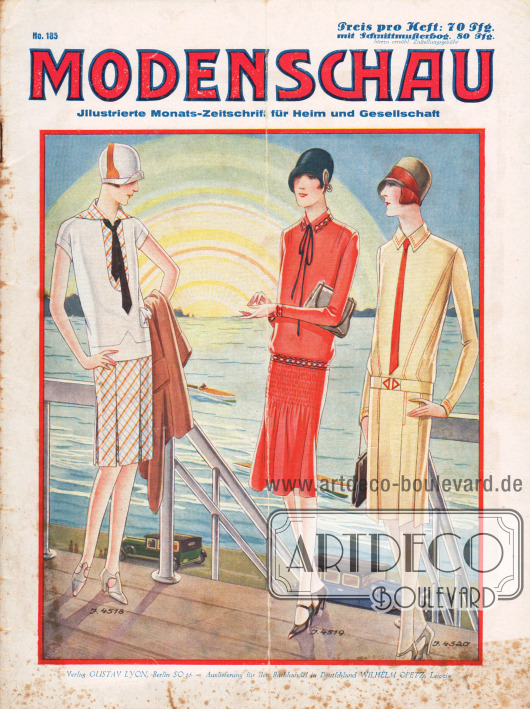|
|

|
Title page or front cover of the German fashion magazine Modenschau (Eng. title: Fashion Show, subtitle: Illustrated Monthly Magazine for Home and Society) no. 185 for May 1928.
Descriptions of the colored cover.
J 4518. Sporty dress made of white and yellow-blue checked rep linen. The latter forms the pleated skirt and the trim of the jumper. Black ribbon tie. Fabric usage: 1.50 m white, 3.60 m plaid, each 80 cm wide. Pattern size 44 and 46. Price 95 pf.
J 4519. Afternoon dress of tomato red wool crepe in a dressy blouse shape. The skirt shows dense shirring and bell pleats in front. Contrasting embroidery border. Fabric usage: 3.25 m 100 cm wide. Pattern sizes 44 and 46. Price 95 pf.
J 4520. Dress in natural-colored shantung silk in a high-necked shape. Red quilting and a tie together accompanied by a belt buckle make up the trimming. Fabric usage: 4 m 80 cm wide. Pattern sizes 42, 44, 46 and 48. Price 95 pf.
Price per copy: 70 pf., with pattern sheet 80 pf., plus local delivery charge.
Publishing house Gustav Lyon, Berlin SO 16 — Distribution for the book trade in Germany Wilhelm Opetz, Leipzig.
Title illustration/title drawing: unknown/unsigned.
|
|
|
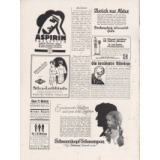
|
Article:
N. N., Anecdotes.
Advertising:
ASPIRIN TABLETS. Original "Bayer" package with the purple band. Available in all pharmacies (BAYER+BAYER).
Slim line even with strong hips thanks to Teufel's Silva Girdle. Available in bandage and corset stores. Brochures, sources of supply free of charge through WILH. JUL. TEUFEL, Stuttgart A 72. Drawing/illustration: unknown/unsigned.
Back to nature is the slogan nowadays! — One goes out, does sports and eats according to calories. People especially recognize the importance of sensible skin care and take advantage of the exemplary properties of genuine Steckenpferd-Lilienmilch-Seife [Hobbyhorse Lily Milk Soap,] which invigorates the skin, frees it from impurities and is indeed unsurpassable in naturally promoting its health. Steckenpferd Lilienmilch Seife.
15 pounds lighter, 10 years younger due to Dr. Ernst Richter's Breakfast Herbal Tea. So writes Dr. A. D. in A.: The tea has served me well, have become 15 pounds lighter and fresher, like 10 years younger. You too can slim down in a healthy way, through this pleasant, tasty drink. Try it today! 1 package Mk. 2.—, 6 packages to success sufficient Mk. 10.—. Institute Hermes Munich S.70, Baaderstrasse 8.
A famous astrologer makes a brilliant offer. He wants to tell you for free: Will your future be happy, blessed, successful? Will you be successful in love, in marriage, in your undertakings, in your plans, in your desires? As well as several other important points, which can be revealed only through astrology. Were you born under a good star? RAMAH, the famous orientalist and astrologer, whose astrological studies and advice have provoked a thousandfold stream of letters of thanks from all over the world, will send you, free of charge, upon the mere communication of your name, address, whether Mr., Mrs. or Miss, and your exact date of birth, by his incomparable method, an astrological analysis of your life and future; which, besides his "personal advice," will contain instructions which will not only astonish you, but thrill you. His "personal advice" contains the power to favorably change the course of your life. Write immediately and without hesitation, in your own interest to RAMAH, Folio 840 E, 44, Rue de Lisbonne, PARIS. A colossal surprise awaits you! — If you wish, you can enclose with your letter Mk. 0.50 in stamps, which are intended to cover part of its postage and other expenses. Postage to France Mk. 0.25.
Iron metal beds, steel mattresses, children's beds cheapest to private. Catalog 96 free. Eisenmoebelfabrik [Iron Furniture Factory] SUHL (Thuringia).
Gray hair gets natural color and youth freshness without dyeing. Brilliantly proven for 20 years. Details free of charge. Sanitas, Zirndorf in Bavaria, Fuerther Strasse 30.
Bow and knock-knees. The leg correction apparatus, which has been proven for decades, heals even older people without occupational impairment. German Reich patent 335318. Ask for a free brochure and advice. Wissenschaftlich orthopaedische Werkstaetten [Scientific Orthopedic Workshops] Arno Hildner, Chemnitz 20. Branch office: Berlin, Am Zoo 20, Kantstrasse 4.
A disheveled little head and two proud braids. The whole family is proud of this lovely little head, whose adorable hair shines with the little face. Most of the time it is a bit disheveled, but it looks lovely and always makes a well-groomed impression. If you want your children to feel good and their hair to always look good, take care of it regularly: wash it every week with Schwarzkopf Shampoo. White pack 20 pfennigs, green "extra" pack with permanent perfume 30 pfennigs (for blondes: "light" variety, for darks: "dark" variety). Schwarzkopf Shampoo. It's all about the "foam"! Photo: H. E. Kiesel, Berlin (biographical data unknown).
|
|
P. 1 |

|
Title page or cover of the Modenschau (Eng. title: Fashion Show, subtitle: magazine for home and society) no. 185 for May 1928.
Article:
Gehrmann, A., The Car for Everyone (by A. Gehrmann, unknown author).
In the center of the article is a photograph showing a lady at the steering wheel of a roadster cabriolet. The caption reads "'I'm just visiting my friend Elli in Potsdam and I'll be back soon.' 14/70 hp Nash roadster (Photo: Willinger)."
Photo: Maurus Wilhelm Willinger, Berlin (1879-1943).
[Gehrmann, A., The Car for Everyone.]
If the number of cars has increased so dramatically in our country after the war, it is not only due to a different attitude of the public toward cars, but also to a different attitude of the factories. Until ten years ago, owning a car was considered a sign of wealth. And rightly so, because the factories were primarily geared to large six-seater cars for touring or elegant limousines for the city, the cost of which was on a par with a middle-class dowry. Since it was also common to leave the driving and maintenance of the car to a chauffeur, the operating costs increased significantly and became even higher with each repair, since the schematization of spare parts had not yet become established to the same extent as today.
You can say what you like about Henry Ford, one of the most controversial people of our time, but you cannot deny him the fame of having pioneered the production of a very cheap small car in America and of having influenced the entire automobile industry in the world. The "Ford," as the vehicle is now called throughout the world, is now completely obsolete, replaced by the manufacturer himself by another type, but once brought the middle classes and even circles below them into the possession of a car and made them independent of other means of transportation.
Similar, though not the same, tendencies are in motion in our country, which will by no means lead to an Americanization of our life, even though economically we are witnessing an ever-increasing convergence to the rational methods of America. We certainly do not have to reckon with those distances which lie between the individual villages and towns in the United States, whose population lived cut off from one another as in the time of the first settlers before the invention of the small car. On the other hand, there is another tendency in our country, which will become even more pronounced after the housing shortage is over: the disaggregation of the cities, which strive for a densely packed business district, for rationally laid-out factory centers, but which move the actual residential areas further and further away from the center, entrusting transportation there no longer to public means of transportation, but to the private car. — In small and medium-sized towns, the urge to own a car is already stronger among representatives of various professions than sometimes in the big city. The busy lawyer, the doctor, both of whom have to travel overland to clients and patients, no longer need to spend hours of their precious time in a horse-drawn vehicle crawling slowly through the sand, as they did in the past. In the spring borne car, all the things they carry are also much better protected than in the wagon, whose bumpy ride has already caused a lot of misery. Also craftsmen, who are needed in the event of sudden disturbances in the countryside, get on much faster in the automobile.
But the car is gradually becoming even more important for the family; indeed, it could be said that modern smooth family life will only develop where a car is available. Perhaps this may sound paradoxical to some ears today, but it is a very human trait that we lag behind the pace of technical inventions. The international film industry still sees the car as a luxury item, and of course it also creates desires of this kind, but above all it is concerned with the popularization of the car, because the future of the car lies in its widespread use and in the simplification of its operation.
The best feature of the car is undoubtedly to make the owner independent of public transportation. The railroad timetable can make no allowance for special requests, but just because of this fact many hours of precious time are irrevocably lost. … [continued on page 2.]
[Page] 1
|
|
P. 2 |
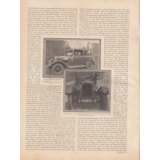
|
Article:
Gehrmann, A., The Car for Everyone (by A. Gehrmann, unknown author).
At the center of the article are two photographs showing two women at the steering wheel of their automobiles. The captions read "'Patience! Master will be here soon!' 8/40 hp Wanderer sedan" and "'I'll quickly do some more shopping.' 10/45 hp Brennabor convertible (Photo: Rembrand photo studio)."
Photo: Rembrand studio, Berlin, Alfred Cohn (1873-1941).
[Gehrmann, A., The Car for Everyone.]
[Continued from page 1] … Who hasn't experienced the agonizing wait on branch lines, where mind-numbingly slow trains crawl through the country at a snail's pace! For the most charming places, unfortunately, have the characteristic of being off the general road. To not a few of them no connection at all leads as hour-long walks from small rail stations. Reaching such destinations by hiking certainly gives young people a lot of pleasure, but not everyone is still suitable to be a wanderer at the age of fifty. A car helps here over all doubts. How difficult it is, especially for a family with small children, to make a trip by train! Children, it is in their nature, are temperamental. Fortunately, they do not yet have any nerves and do not know that they sometimes disturb fellow passengers without meaning to. Now not all of our contemporaries are so tactful as to allow the child's right to enjoyment to prevail, although it should be noted, of course, that spoiled or improperly brought up children can become a nuisance in a railroad car. Many a collision between adults has occurred for this or some other reason. People have been crammed together for hours in a very confined space whose characters did not match. Unfortunately, during such journeys, everyone is at the mercy of blind chance, which puts them in an environment they cannot resist. Only the car can free us from this worry, indeed, we can now determine our company and calculate what impressions will come to us from the side of our fellow travelers. One of the greatest advantages of the car is that it puts the disposition of time and place completely in our hands. Any distance can be measured according to the map, which is already produced in special editions according to the special needs of the motorist. If it is divided by the number of kilometers one wishes to cover by car (speed records are not to everyone's taste, although in the course of time the aversion to high speeds fades), the number of hours necessary to reach a destination is easily found. The car also gives us the time at which we want to set off. How many times before have we not been in merry societies, in charming places of excursions, which we had to end in the best mood with sudden departure, because later there were no more possibilities to return home. Those who own a car are free of this worry, which has already spoiled many a pleasant evening.
Now, many of our fellow citizens would certainly like to own a car, but they do not get beyond this desire and never made the attempt to obtain in-depth information about the possibilities of getting a car. Quite a few people are still under the impression that a car is very expensive to buy and expensive to keep. Well, if you want to buy a luxury car, you have to dig deep into your pockets, but a car that is sold as a type article for the general public is affordable even for the lower middle class. It is sometimes argued that even a small car for the middle class is still a luxury, but this viewpoint is completely outdated and not in keeping with the technical level of our time. The extent to which the concept of what is considered a luxury and what is considered a necessity changes over the decades can be illustrated by an example. Eighty years ago, even in well-bourgeois circles that could rely on a certain fortune, no carpets or painted floorboards were to be found. One had scrubbed floor, which was sprinkled with sand. Carpets came from the Orient in those days, and where there really was such a piece in a middle-class home, it served as a wall decoration. When the poet Paul Heyse brought home his quite wealthy wife, and she received a carpet as a wedding gift, this was considered by his friends and relatives belonging to the good society as unbourgeois and ostentatious! We think about it quite differently. We can no longer imagine a bourgeois home without a carpet, and the lack of one would be a sign of great poverty. But it is exactly the same with the car. The luxury automobile corresponds to the oriental carpet, both of which are still reserved for a small stratum of very wealthy circles; the domestic commodity, however, be it carpet or car, is increasingly becoming the property of the general public.
The automobile industry, the most modern of all industries, has increased its products to such a high level and composed them in such a diverse way that every wish can be satisfied even without special production. Whether one should prefer the limousine or the touring car, the closed or the open car, is a question that depends on the needs of the individual. The sedan is the typical city car, which of course does not fail in touring, but due to its design has a somewhat hot interior in the summer. On the other hand, the sedan is very pleasant in winter, especially if the car is equipped with interior steering, because it protects against the inclemency of the weather. Of course, the open touring car can also be seen inside the city. A folding top, the installation of which is the work of a few seconds, protects from rain, but not from the cold, but the touring car, because of its design, is also widely used in winter for trips overland. The number of family members determines whether a two-seat or four-seat car is purchased. … (continued on page 8).
[Page] 2
|
|
P. 3 |
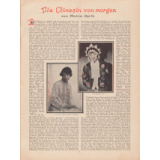
|
Article:
Opitz, Annie, The Chinese Woman of Tomorrow (by Annie Opitz, unknown author).
Matching the article are two photographs. The captions read "The Chinese woman once…" and "…and now. (Photo: Becker & Maass.)"
Photos: Studio Becker & Maass, Berlin.
[Page] 3
|
|
P. 4 |
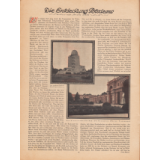
|
Article:
Sell, Anita, The Discovery of Potsdam (by Anita Sell, unknown author).
The two photographic images selected for the article have the captions "Modern Potsdam: The Einstein Tower" and "Historical Potsdam: The Orangery (Photos: Transocean)."
Photos: Transocean News and Picture Agency (1915-1945).
[Page] 4
|
|
P. 5 |
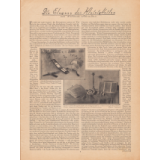
|
Article:
Schreiber, Antonia, The Elegance of the Small Accessories (by Antonia Schreiber, unknown author).
The article is accompanied by two matching photographic illustrations. The captions read "Even the little things in your bag are elegant! Comb, curling iron and sewing case. [Photo: Becker & Maass]" and "Modern handbags, snakeskin on the left, lizard skin on the right. Center: elegant cigarette case with mosaic inlay [Photo: Sandau].
Photos: Becker & Maass studio, Berlin; Ernst Sandau (1880-1918, studio taken over by Suse Byk, 1884-1943).
[Schreiber, Antonia, The Elegance of the Small Accessories.]
It can't be denied: the little things make it! What is the use of the most beautiful dress, the most fabulous ensemble, and the fanciest hat, if all the little odds and ends, over which men smile so contemptuously, do not go with it? They have no idea, the men! It is precisely these thousand little things, this whole "useless" (of course!), impractical trimmings that give our whole appearance its chic. That is just the tip of the i. Otherwise, we could also dress in your much-vaunted practicality, which — let's be clear about this! — is really anything but beautiful! Of course, we don't demand "pictorially" dressed men — cinema stars are enough for such ambitions; and otherwise the inconspicuous foil of the man is just what we need to show off sufficiently ourselves. Since we women chat among ourselves, we can confidently admit that! But we have to demand a little more respect for all the things that seem important to us. Granted that bags in a suit are more practical than the ones you carry around with you; but — the line! Should we, who chastise ourselves, who anxiously entrust ourselves daily to this dreadfully inexorable scale, voluntarily widen our girth? Never ever! It goes splendidly with the bag in the hand! No, gentlemen, not only because otherwise we would not know where to put our hands! Thank God we are not clumsy. But it gives such a delightful opportunity, this bag, to handle it, to show dexterity in dealing with staff, with cashiers, waiters and similar people, who, as we know, take money out of our pockets. It is a delightful opportunity to reveal one's taste and personal style, because the way the bag or pouch is opened reveals a woman's culture — but the way the bag looks — whether it is large or small, whether it goes with the suit, whether it is chosen for the occasion — can show the attentive observer everything, everything! If you appear at teatime in the afternoon in the elegant hotel lobby with a large leather handbag with a practical handle, it can look chic if you make any effort at all to prove your personal touch by wearing a strictly sporty suit, but it can also mean a serious mistake if you wear a silk ensemble or some elegant tea dress with it. Then neither quality workmanship and leather of the bag, nor the slide fastener according to the latest fashion, the most beautiful model dress helps nothing — you are and remain in this outfit an impossible appearance! One thing does not fit all. And that is good! Otherwise we would have no bag fashion; a misfortune — not to be foreseen! We would not have the opportunity to consider the all-important question, "Which bag goes with which dress?" We would not be able to unfold the most personal luxury, if a snake fashion allowed us to feel the smooth little skin of the snake at least in our hand — as a bag or as a glove! We would have no chances to call our own those pretty collections of more or less large bags and pouches, which today make it a pleasure for us to put together a dress ensemble. Now we can choose to the jumper dress between all kinds of large bags, some in flat envelope shape, some worked as bags wrinkled with clamp. Every kind of leather and every kind of processing is used. True composition games of leather we can sometimes see. The industry is very active! Ensembles are also at our disposal, of course: Bag, shoes and gloves matching each other. And this brings us to the most important thing for all the little things at all: harmony! Only then they will have the desired effect, which we strive for, if they fit harmoniously to the whole costume not only in form and style, but also especially in color. But fortunately there is a huge selection in all shades of sand, beige and gray. For the afternoon dress, things are already more comfortable: the beautiful black silk bags embroidered in petit-point or with Chinese motifs — always up to date! — embroidered black silk bags, envelopes and pouches, go with everything. But the demand for uniformity goes further! All the many small and smallest things that rest in the little bag, should actually match other. The billfold and the purse, of course, but also all the small, otherwise indispensable trousseau of the sophisticated woman: powder compacts, lipstick, cigarette box and tip. There are no restrictive limits, except for those set inexorably by our own purse. But already in cheapest execution all these things are to be had today charmingly matched to each other! Culture of taste! — An important chapter in this are also the corsages. If they fit, they are delightful — if they are too big or even not chosen in the right shade, they can jeopardize the whole impression of the suit. Jumper dresses and tailored suits call for more delicate jewelry than tea and evening dresses. Beautifully worked single blossoms compete with finely and elegantly shaded boutonnieres, also the latest fashion for suits, but which should probably be added to the dresses. These flowers are small works of art! Where have the times gone when people thought they could only wear French flowers? Today our domestic industry of artificial flowers is so fabulously perfected that it even beats foreign countries! Fairy hands seem to have created these blossoms, often wonderfully copied from nature, and artists have given them their delicious colors. And now these outrageously refined stylized flowers in their capricious bizarreness just to the simple jumper dresses, the snappy straight costumes and coats as piquant contrasts! First artisans compete in creating the models after which the docile workers can then form these small works of art. Velvet, silk, even leather and small cork plates are used to provide pliable material for the artificial floral splendor, not forgetting crepe georgette and chiffon, which, however, are more suitable for those magnificent giant flowers and graceful floral tendrils that give our tea dresses and elegant evening toilets an extra charm. Here also the extensive wild rose can celebrate triumphs, the newest Russian knapweed, very artfully glued and tinted, can look enchanting! … (end page 45).
[Page] 5
|
|
P. 6 |
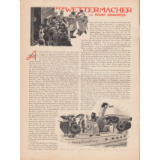
|
Article:
Hirschfeld, Georg, The Weather Maker (by Georg Hirschfeld, 1873-1942).
There are two illustrations for the short story. The top left illustration shows a crowd of people in front of a barred window on a post office building. The second illustration shows a company on a river steamer named Seeschwalbe. Since it is raining, some guests have opened umbrellas. The caption reads "Suddenly the sky had turned gray and it began to drip."
Drawings/illustrations: unknown/unsigned.
[Page] 6
|
|
P. 7 |
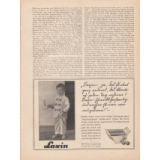
|
Article:
Hirschfeld, Georg, The Weather Maker (by Georg Hirschfeld, 1873-1942).
Advertising:
"Laxin —, yes, that's something completely different, I could take that every day! Laxin tastes great and afterwards you feel like you've been reborn!" —
Children usually have a violent aversion to nasty-tasting laxatives. Give your child Laxin, whose pleasant fruit taste all children love and which works mildly and safely, your child will thank you by being healthy and cheerful. *
The interesting brochure about "Laxin" free of charge from Lingner-Werke [Linger Works] in Dresden. Laxin. Photo: unknown/unsigned.
[Page] 7
|
|
P. 8 |
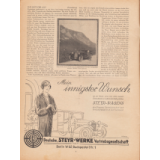
|
Article:
Gehrmann, A., The Car for Everyone (by A. Gehrmann, unknown author).
In the center of the article is a photograph showing a cabriolet against an imposing mountain backdrop. The caption reads "'This ride through the Gailtal [Gail Valley] in the 6/30 hp Steyr will remain unforgettable to me!' (Photo: Karl Zapletal)."
Photo: Carl Zapletal (or Karl Zapletal, Austrian photographer, 1876-1941).
[Gehrmann, A., The Car for Everyone.]
[Continued from page 2] … A young married couple will usually get by with a two-seat car, unless both intend to invite friends for an outing more often. For a family with several children, on the other hand, a four-seater car is necessary, especially since such a vehicle can comfortably accommodate five people. In some brands, which should be carefully examined for such purposes, it is even possible to take a sixth person, if there are three adults and three children. Nevertheless, no one needs to buy a car with a view to family growth. The automobile industry is not a rigid, but a commercially very flexible entity, which tends to meet all the wishes of its customers in a way that is advantageously different from the usual practice of the trade in our country. For example, it is possible to trade in a car that has been used for years when buying a new one, whereby the old car is not only invoiced with a junk price, but is precisely assessed for its wear and tear and further possible use. A couple that, childless, was content with a two-seater car, can trade it in for a larger car at any time, as soon as family starts to arrive, without incurring excessive costs.
Many car lovers would very much like to be in possession of a car, but they keep delaying the acquisition of one because they do not yet have the means to pay for it all at once. Especially in our bourgeois circles, the aversion to any partial payment is widespread. The milieu and influences of education make it impossible, especially for older members of these circles, to buy anything other than immediate payment. In itself, this point of view is very honorable, but it has, like many things from the time of our grandfathers, only conditional value. In those days there was some money in all families, the needs were of a different kind, and to satisfy them one fetched the money from the bank. Today, the accumulation of capital is just beginning again. If one wanted to fulfill all one's desires only as soon as the sum belonging to it is collected, life would be poorer by some comfort. So why wait with the acquisition of an object, as soon as the credit possibilities make its possession possible for us on more comfortable and faster way! In America, where people are not more frivolous than in our country, partial payment for larger items is an integral part of life. Even very wealthy people abroad are accustomed to buying cars on credit. Therefore, if you want a car, you should inform yourself about the various ways in which it is possible to obtain a car without paying the full purchase price. … [Continued on page 10.]
Advertising:
My dearest wish is to own a STEYR-AUTOMOBILE, so extraordinarily praised by all my friends, which combines elegance, reliability and value for money. ((STEYR)) German "STEYR-WERKE" Vertriebsgesellschaff m.b.H. ["Steyr Works" Distribution Company] Berlin W 62, Budapester Str. 1. Drawing/illustration: "DOERFEL" (unknown artist).
[Page] 8
|



